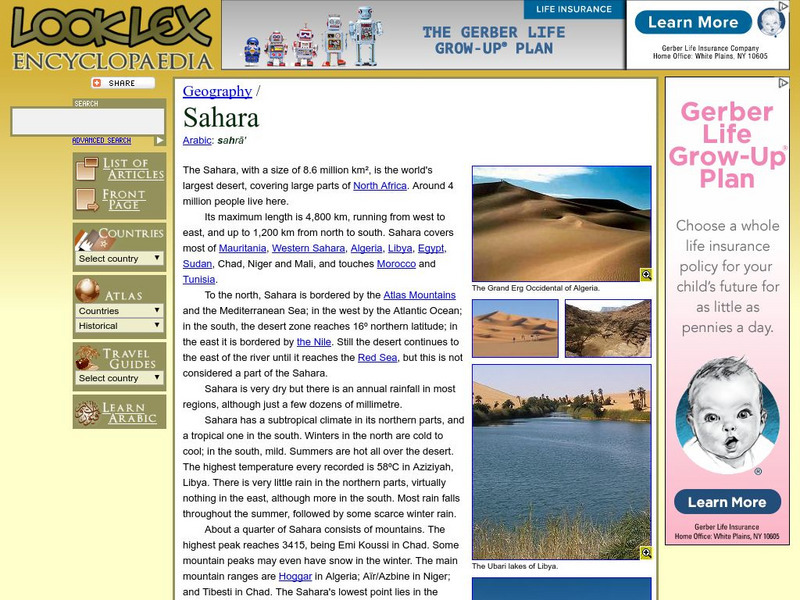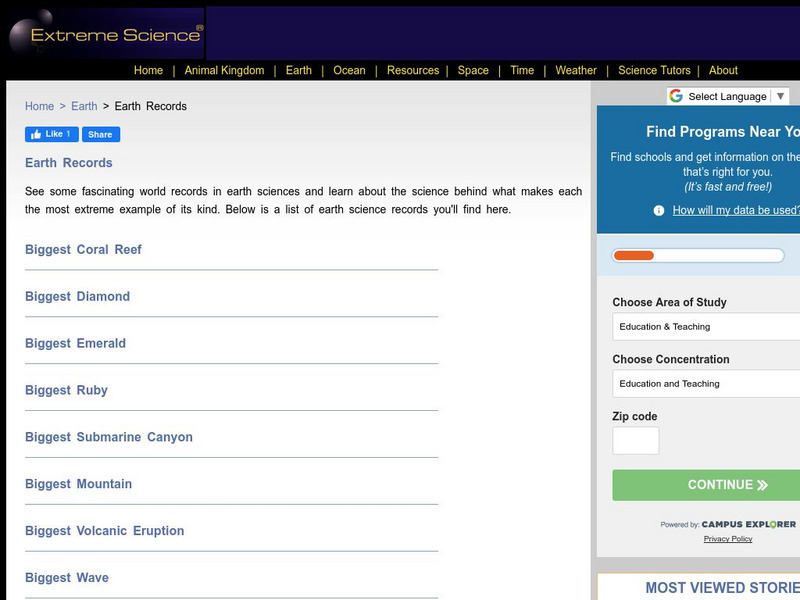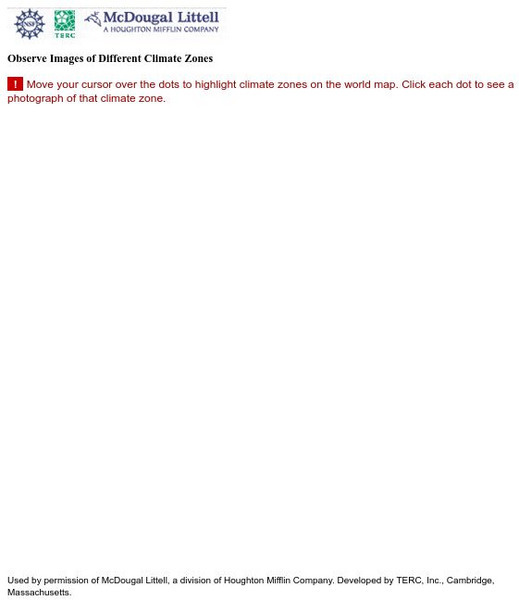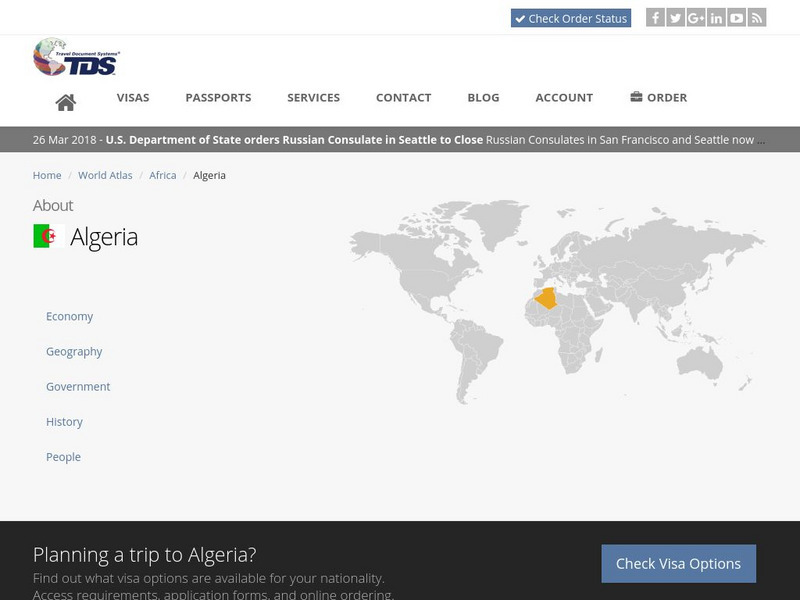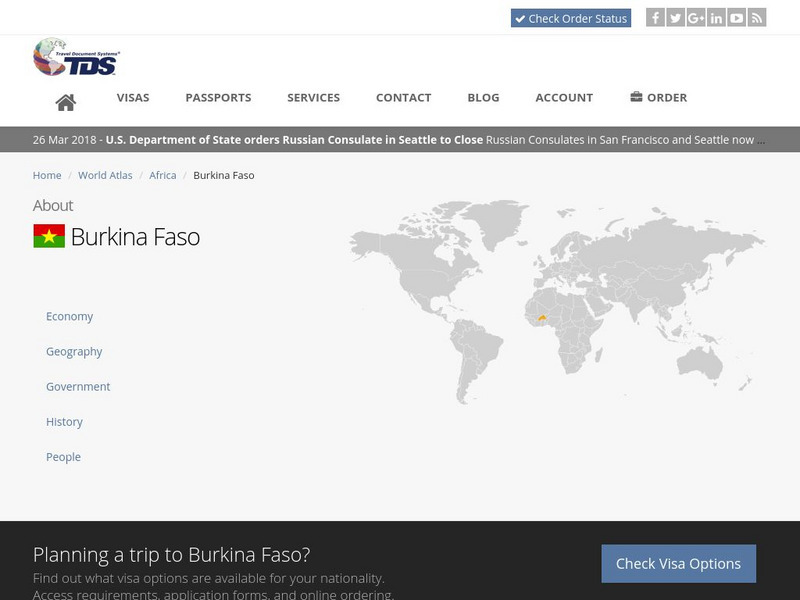Texas A&M University
Ocean World: Icebergs
This site discusses where these monstrous blocks of ice come from and how they are formed. Also provides links to an interactive quiz, real-time data, icebergs in the desert, and more.
OpenStax
Open Stax: From Cold War to Culture Wars, 1980 2000: A New World Order
Page featuring information on a changing order both at home and abroad during the 1980s. Several links to primary source material, glossary and questions for student discussion.
LM Digital Media
Kids World Fun: Waldo and the Desert Island Adventure [Pdf]
The ebook shares an imaginative adventure of a boy and his dog. In their imaginary voyage, they travel to a desert island.
Mocomi & Anibrain Digital Technologies
Mocomi: Major Biomes of the World
Covers the major types of biomes: tropical rain forest, arctic tundra, coniferous forest, deciduous forest, desert, grasslands, and mountains.
Other
Encyclopaedia of the Orient: Sahara
Information about the world's largest desert, the Sahara, including size, location, people, climate, physical features, and animal life. Includes a chart of temperatures (in Celsius) and rainfall (in millimeters) by month and by yearly...
World Geography Games
World Geography Games: Deserts
Identify the world's major deserts by taking this interactive quiz.
The History Cat
The History Cat: Geography: Places: Atacama Desert
Describes the Atacama region of Chile and why this area is so dry.
Discovery Education
Discovery Education: Habitats of the World
This site has a lesson to use to start a unit on biomes and animal habitats. This plan incorporates grasslands, temperate forests, tropical rainforests, deserts, polar ice regions, and tidepools.
Extreme Science
Extreme Science: World Records in Earth Science
What is the highest elevation on earth? How about the driest place on earth? Do you know where the greatest earthquake took place? Let Extreme Science take you to these places and other extreme places around the world.
Ducksters
Ducksters: Science for Kids: World Biomes and Ecosystems
Kids learn about the world's biomes and ecosystems. The network of life and biodiversity needed for all to survive.
Channel 4 Learning
4 Learning: Geography Essentials, Weather Around the World
This resource offers in-depth information on weather and different types of climate including desert, tropical rain forests, and more. Also provides worksheets (Word documents) and images relating to weather.
Other
Wwii North Africa Campaign: Erwin Rommel
A biography on Erwin Rommel in North Africa, otherwise known as the Desert Fox, the leader of German troops in Africa.
Missouri Botanical Garden
Missouri Botanical Garden: Rivers & Streams of the World
A great site from The Evergreen Project that provides information about watersheds, how a stream becomes a river, when rivers run into the ocean, longest rivers of the world and much more. There are also other sections of this site that...
PBS
Pbs Learning Media: Observe Images of Different Climate Zones
Interact with this world map from McDougal Littell/TERC to highlight different climate zones and see a photograph of each one. Ten climate zones are represented, including tundra, desert, humid subtropical, and others.
Travel Document Systems
Tds: Libya: Geography
A brief look at the geography of Libya listing information from the CIA World Fact Book. Find out about the climate, environment, resources, and land use.
The History Cat
The History Cat: Geography: Environment: The Incredible Shrinking Sea
Describes the economic policies of the Soviet Union that turned the Aral Sea, once the world's largest body of fresh water, into two smaller seas and desert. Includes a video. [10:29]
Travel Document Systems
Tds: Algeria: Geography
A discussion of the geography of Algeria. You can read about the three distinct geographic regions, the climate, and the natural hazards. Information from the CIA World Fact Book.
Travel Document Systems
Tds: Burkina Faso: Geography
Read this article to find out about the geography, climate, wildlife, and size of Burkina Faso. From the CIA World Fact Book.
Curated OER
Desert Picture
Explore the Namib Desert and learn about its location, the Skeleton Coast, mirages, and general information about this home to the highest sand dunes in the world.
Smithsonian Institution
National Museum of American History: The Price of Freedom: Americans at War
View comprehensive sets of artifacts that tell the story of America's wartime past and present. Artifacts from every major American military conflict, beginning with the American Revolution, can be closely examined. Full curatorial notes...
Other
Los Alamos National Laboratory
The official website of the Los Alamos National Laboratory. You will find the history of the laboratory as well as many of the key figures. There is also an interactive history of the Manhattan Project. Be sure to check out the photo...
National Earth Science Teachers Association
Windows to the Universe: Climate Changes With Latitude
A map showing the division of the world into eight biomes based on different climate types around the world. There are links to more information about each biome.
Independence Hall Association
U.s. History: Wartime Stategy
Initial focus by the Americans in World War II was containing Germany. Read about the Allied war stategy to "close the ring" and deprive Germany of men and materiel.
BBC
Bbc: Nature Wildfacts: Dromedary Camel
The world's most common camel is the Dromedary. Find out more on the Dromedary through this detailed fact sheet and photos.
Other popular searches
- World Deserts
- Maps World Deserts
- Worksheet on World Deserts
- Major World Deserts
- World Deserts Lesson Plans




